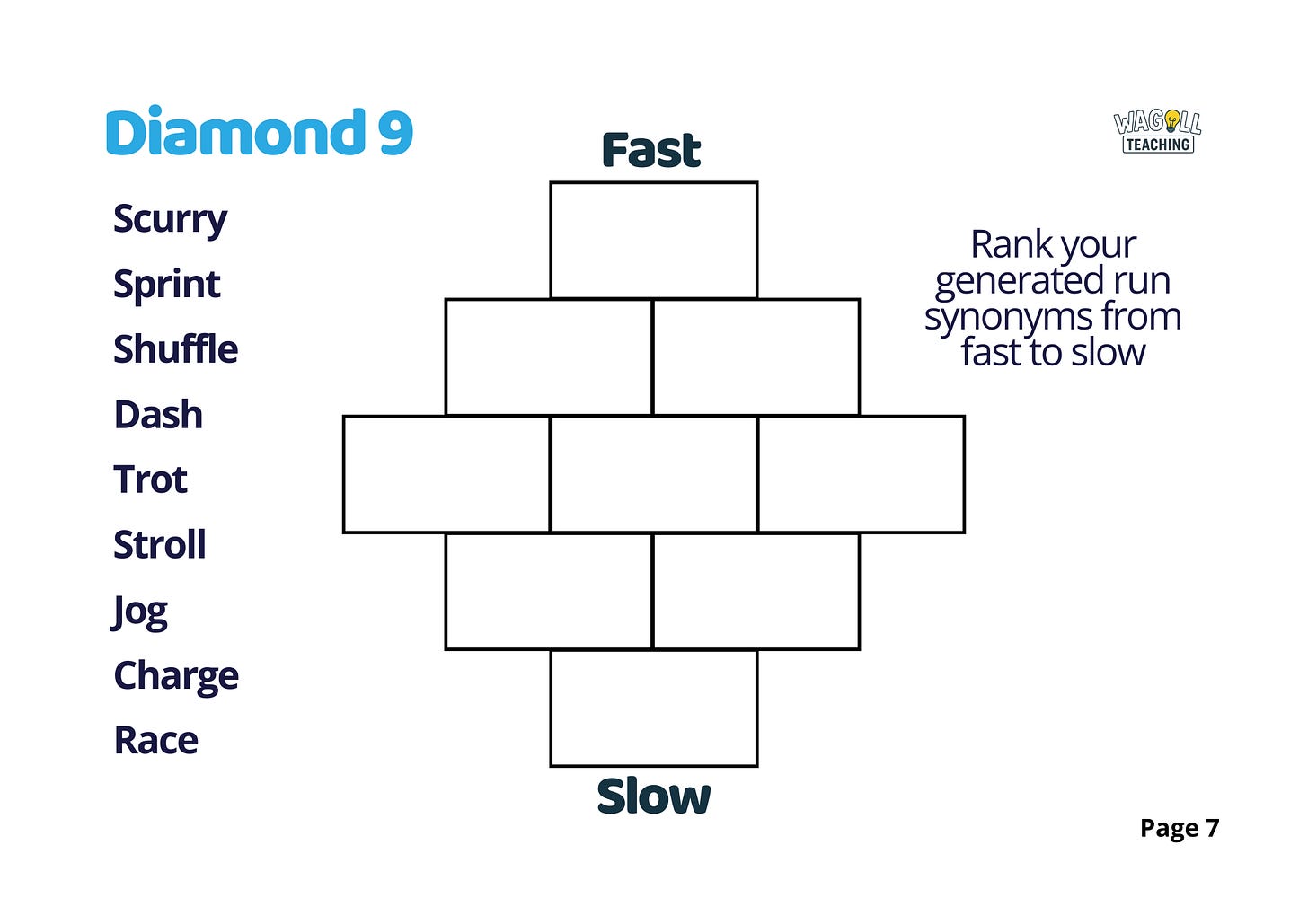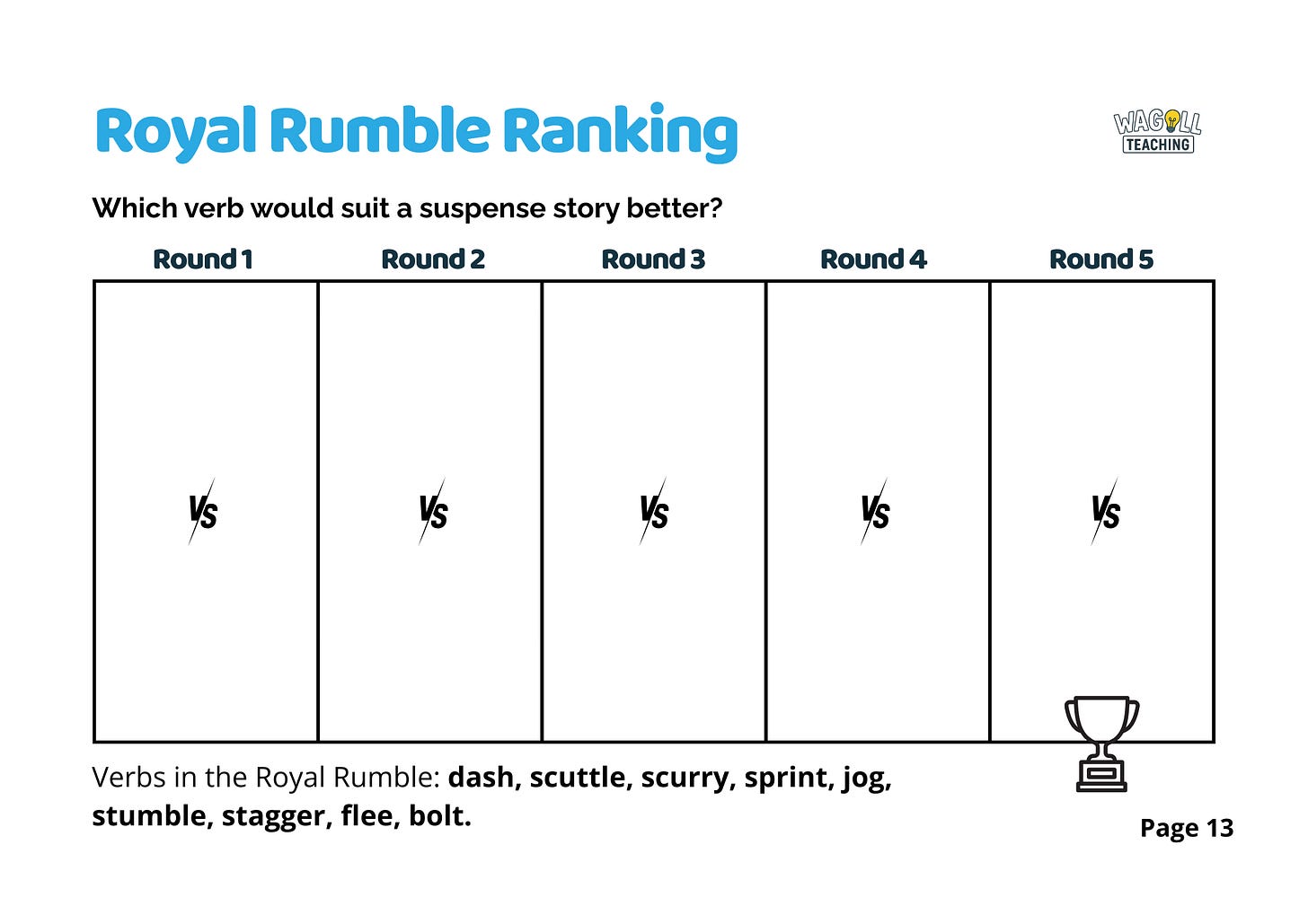Ranking and Comparing Knowledge: Designing Tasks That Help Children Think Part 4
Ranking and comparing tasks don’t just help children order information, they help them decide what matters most.
📚 Catch Up on the Series
Missed a part? Here’s what we’ve covered so far:
📦 Part 1: Organising Knowledge
Why organising knowledge makes learning stick — and how it helps shape what children remember.
🧱 Part 2: Selecting Task Types
Choosing the right structure to match the thinking: Compare, Sequence, Cause & Effect, Chunk.
Six powerful task examples that group ideas into meaningful mental ‘buckets’.
🏅 Part 4: Ranking and Comparing Knowledge
From Diamond 9s to Target Maps — helping children weigh, prioritise, and reason.
🔁 Part 5: Sequencing Knowledge
From timelines to swim lanes — helping children structure ideas, actions, and events so they flow and make sense
⚙️ Part 6: Cause and Effect Knowledge
From fishbone diagrams to consequence maps — helping children understand why things happen and what they lead to.
💡 The Big Idea
Ranking and comparing tasks help children connect, contrast, and prioritise ideas. They encourage deeper thinking by asking pupils to judge, categorise, and weigh information.
In this post, we’ll explore examples of ranking and comparing tasks across phases, show how they can be used at different stages of instruction, and share six practical task examples, including two from FS/KS1 provision.
👀 A Closer Look
Ranking and comparing tasks aren’t about creating neat, ordered lists; they’re about teaching children to think relationally between things that could potentially be quite similar.
When we rank and compare, we help children recognise key similarities and differences or evaluate the significance or impact of ideas and events. Ranking and comparing can also help children prioritise certain information to emphasise what is most important. Let’s dive into six practical examples.
🎯 Example Task 1: Target Map
Children place facts, events, or ideas into concentric circles, ordering them from ona. scale of your choice. In this example, they are ordering from “most important” (centre) to “least important” (outer rings). In a target map, there can be more than one idea in each circle, which means pupils must group items that share similar levels of significance, not just rank them in a strict order.
✏️ Used for: Evaluating importance and developing reasoning
🔎 Why it works: Pupils must weigh different ideas and make strategic decisions, supporting retrieval and prioritisation in later tasks.
🔷 Example Task 2: Diamond 9
Children are given nine ideas (or generate them) and arrange them into a diamond shape, with the most important or strongest idea at the top and the least important at the bottom.
✏️ Used for: Prioritising and justifying knowledge
🔎 Why it works: It encourages pupils to think critically about value, importance, and strength, sparking rich discussion and cognitive conflict.
🎲 Example Task 3: Counter Ranking
Pupils are given a selection of options (characters, events, or ideas) and asked to rank them in order using counters or numbered placeholders. In this example, pupils rank characters in Oliver Twist by their level of influence. Rather than being a static task, Counter Ranking can become a dynamic speaking and listening activity. Pupils begin by placing their counters based on initial opinions, then adjust their positions as the discussion unfolds and new arguments are presented. This live re-ranking promotes rich dialogue and flexible thinking.
After the discussion, pupils can record their final rankings in their books using a mini version of the frame, and use sentence starters or pre-written explainers to justify their reasoning. This approach builds confidence in oral explanation, reinforces subject knowledge, and strengthens evaluative writing.
✏️ Used for: Supporting structured comparative thinking
🔎 Why it works: It demands both choice and justification, developing reasoning skills across subjects.
🥊 Ranking Task 4: Royal Rumble Ranking
In this task, children pit words, facts, or ideas head-to-head in rounds, like a knockout tournament, to determine which is most effective, important, or relevant for the learning focus. In this example, pupils compare verbs to decide which one would best suit a suspense story.
In round 1, dash vs scuttle could be compared. If you believe scuttle is better, scuttle moves into round 2 column with dash remaining in round 1, ready for the next comparison. The next word introduced might be scurry. Scurry is compared to dash in round 1. If it wins, it is then compared to scuttle in the round 2 column.
✏️ Used for: Vocabulary refinement and purposeful comparison
🔎 Why it works: Unlike the other tasks, it provides a step by step process for comparing ideas. The structure keeps it controled and playful while promoting decision-making.
👧 Practical FS/KS1 Ideas
Ranking and comparing isn’t reserved for Key Stage 2. In Early Years, it’s about developing early decision-making, evaluating choices, and comparing attributes.
🌦️ Example Task 5: Weather Watch Ranking (Enhanced Provision)
Set up a weather station area with picture cards showing different weather types (sun, snow, rain, wind, fog, etc.). Invite children to rank the weather from “best for playing outside” to “worst for playing outside.”
Encourage discussion: “Why is rain lower than wind?” “What might make snow fun or tricky?”
🔎 Supports:
Understanding the World – The Natural World (ELG)
Communication and Language – Speaking (ELG)
Creating and Thinking Critically (COEL)
🧠 This task develops reasoning and comparative language (“better than,” “less fun,” “more dangerous”) while supporting expressive language and decision-making.
🧱 Example Task 6: Building Blocks Showdown (Continuous Provision)
In the construction area, provide blocks of various materials (foam, wood, plastic, cardboard). Encourage children to compare and rank the blocks by strength, stability, or height when building. For example: “Which block makes the strongest wall?” or “Which ones fall over first?”
You might set up prompts or photo cards showing the stages of skill development to help children recognise and talk about what they’re doing.
🔎 Supports:
Mathematics – Numerical Patterns (ELG)
Understanding the World – Materials (ELG)
Creating and Thinking Critically (COEL)
🧠 Through open-ended exploration, children compare and evaluate based on experience. They use early scientific reasoning to decide what works best and why, all embedded naturally within play.
🧭 Wrapping It Up
Ranking and comparing goes beyond ordering — it’s about reasoning, evaluating, and prioritising.
These tasks help children weigh knowledge and test ideas against each other.
They support purposeful decision-making and critical thinking.
Activities like ranking superhero powers, Roman inventions, or rainforest threats teach children to structure knowledge relationally.
This sharpens thinking and strengthens schema through meaningful comparisons.
📥 Download the Free Task Design Toolkit
Want to use these examples in your classroom or share them with your team?
I’ve created a downloadable Task Design Toolkit, including:
✅ 6 task examples in each pack
✅ Practical ideas for making each task active and embodied
✅ Extension and scaffolding suggestions for all learners!
🚀 What’s Next?
In Part 5, we’ll move on to Sequencing tasks, where children learn how to order events, processes, and ideas to build a coherent, connected understanding across the curriculum.
📚 Sources & Inspiration
This post draws on the brilliant work of educators, researchers, and generous online communities. While the tasks and examples have been adapted and developed for the primary classroom, many of the underlying ideas are grounded in the work of the following individuals and groups:
🧠 Books & Research
David Goodwin & Oliver Caviglioli – Organise Ideas: Thinking by Hand, Extending the Mind
🌐 Online Educators & Threads
James Fitzpatrick (@mrfitzhist) – for insightful history task design and questioning
Karl McGrath (@MRMICT) – for ideas around task design and retrieval challenges
Oliver Caviglioli (@olicav) – for dual coding and visual explanation frameworks
💬 Communities
Primary Task Design Facebook Group (led by @MRMICT) — a highly active space where educators generously share practical task structures and thinking routines
📝 More from WAGOLL Teaching
The Ultimate List of Books for Research-Informed Teachers ➡️ We’ve pulled together The Ultimate List of Books for Research-Informed Teachers - a handpicked collection of must-reads to boost your practice, challenge your thinking, and keep you at the cutting edge of education.
Exploring Success Criteria - Make Them Dynamic and Accessible ➡️ By presenting success criteria in a more dynamic and relevant medium, meaning can be made, and links can be made to prior learning. Success criteria need to be made domain, subject, and age group specific.
Retrieval Practice: 7 Activities That Work in Primary ➡️ A handy list of retrieval activities for Primary children
In a bit,
Coops 😎











